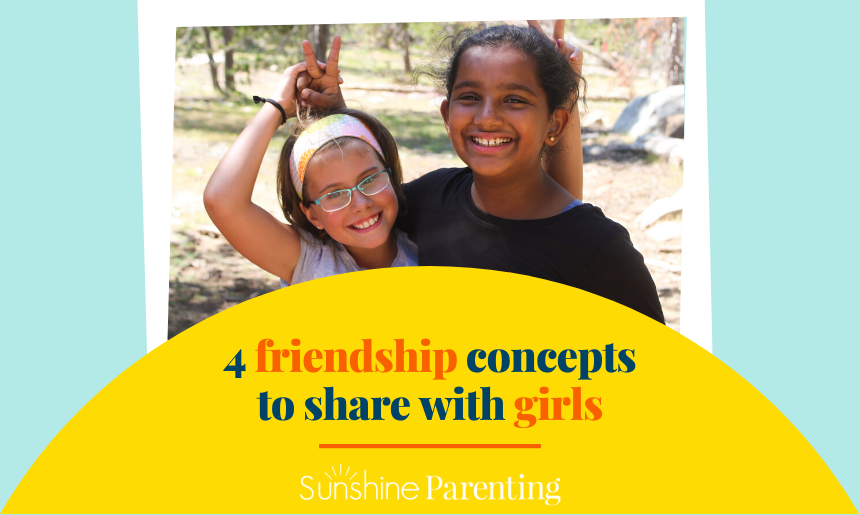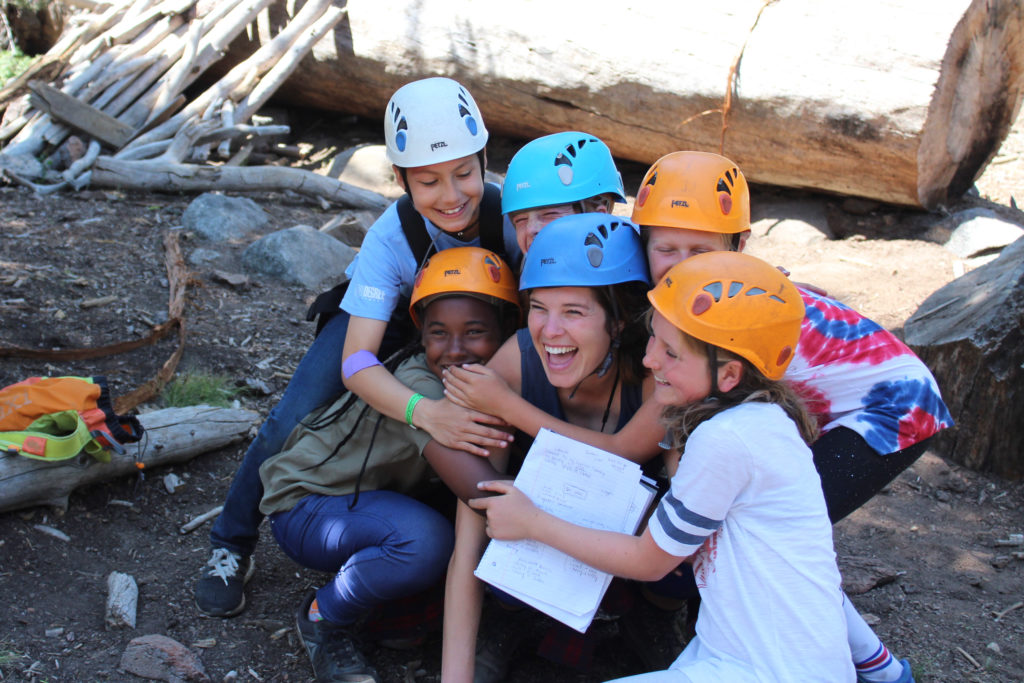4 Friendship Concepts to Share with Girls
 In researching and planning for a talk I gave a few weeks ago about girls’ friendships, I read through some excellent resources, including these books. I also wrote this post about ways to help your daughter become a thriving adult.
In researching and planning for a talk I gave a few weeks ago about girls’ friendships, I read through some excellent resources, including these books. I also wrote this post about ways to help your daughter become a thriving adult.
While many concepts I write about friendship apply to both boys and girls, there are some that seem to loom more largely in female friendships. Here are some ideas our daughters may need some help learning as they navigate their friendships.
#1 The Ups and Downs of Female Friendships
Female friendships, as with all relationships our kids will experience throughout their lives, will have inevitable ups and downs. The ups provide the sweetest memories of a girl’s childhood and adolescence, and the downs provide the most painful.
Some of our most painful moments as parents will be when our daughter faces the downs in her female friendships. Helping and guiding her to understand that both the ups and the downs are a normal part of relationships may not ease her pain much but will help guide her to be resilient about continuing to seek the ups.
Ups:
- Fun: Girlfriends can be the best thing ever! Adult women still meet with girlfriends and can get stomach aches from laughing so hard.
- Someone to talk to: Long chats on the phone perhaps have been replaced by long SnapChat streaks or lengthy text conversations, but the massive amount of communication that goes on between girls remains the same. Girls love to communicate and share with one another!
- Sharing Secrets: Sharing confidences is one of the joys of female friendships. Whether girls are sharing who they have a crush on in 5th grade, a difficulty with a teacher in high school, or the pain of their parents’ divorce, good friends provide a safe place for girls to share and comfort one another.
- Celebrate: Friends remember each other’s birthdays and celebrate one another to make them feel special.
Downs:
The biggest down our kids will experience (like we did, too) is “losing” a friend. Losing a friend can happen in many different ways, but it hurts regardless:
- Relocation: When a girl moves to a new city or school and leaves friends behind, that can be painful.
- Changing Interests: Girls transition to different interests and may no longer have as much in common with one another. Perhaps it was a sport or club that brought the girls together and is no longer a shared interest. Or, perhaps one girl is moving on to more mature activities or relationships (maybe to the detriment of their well-being), and the other wants to stay in girlhood longer. As long as both girls find or have other peers with similar interests and values, these friendships ending often don’t cause as much pain.
- Rejection by a former “BFF”: The most painful down of friendship is rejection by a girl considered a “best friend.” When one friend decides they no longer want to be friends with the other, and the feeling is not “mutual,” the breaking up of the friendship can be incredibly painful and difficult for our girl to grapple with. It’s important for parents and other adults who work with girls to understand that the end of a friendship is felt emotionally often as strongly as the breakup of a romantic relationship.
- Exclusion: A group of friends of which our daughter has been a part starts excluding her. The “mean girls” who use relational aggression to leave girls out are real – and being the recipient of either their exclusion or aggression is extremely painful.
 # 2 You Can’t Have 10 “Best Friends” (The Tip of the Triangle is Small)
# 2 You Can’t Have 10 “Best Friends” (The Tip of the Triangle is Small)
Shasta Nelson’s Frientimacy Triangle (featured in her book by the same name and on her website) offers a great visual for how relationships develop into stronger friendships over time. I love how she explains that we have friendships all along the triangle and being at the bottom or the middle of the triangle is not a bad thing, it’s just the reality of relationships. Good, solid relationships take both consistency and increasing vulnerability over time to make it up to that top point.
If your daughter thought someone was a “best friend,” but perhaps the other person views your daughter as someone not as high on their “triangle,” this can lead to hurt feelings. Explaining to your daughter about how to nurture closer connections and keep people joining and moving up the triangle expands her understanding of how friendships develop over time.
#3 Finding Your “Tribe”: The Difference Between Fitting in & Belonging
Because our girls are constantly inundated with messages about what they should look like, enjoy, and do, it can be hard for them to be in touch with what they actually like and want.
As often as you can, seek out your daughter’s opinion about what she is interested in, what she wants to do, etc. Help her try out and discover new activities, hobbies, sports, and watch what gets her excited and engaged. What we’re all seeking is to get in that wonderful state of flow where we are enjoying ourselves so much that we lose track of time. When we find activities that get us into those states, we often find peers with similar interests. Sometimes, we even find our “tribe.” This often happens with kids in high school who get involved in theater, marching band, or, in my daughter’s case, Academic Decathlon. When you find something you enjoy, you often find “your people.” I still find this true. I love talking with and being around people who work with kids and want them to thrive.
Our girls can easily get so caught up in what everyone else is doing that they forget to ask themselves, “What do I like?” Helping your daughter distinguish between when she’s doing something to fit in versus doing something she really wants or enjoys is an important distinction that can have lasting, positive implications.

#4 Popularity is Not as Great as it Seems (Pitfalls of Popularity / Understanding the Sociometric Spectrum)
“Popular” often means more powerful as opposed to having more real friends. Sometimes, popularity comes with a price, however; kids who are popular are often on the fast track (drinking, drugs, sex) because such activities help them “fit in,” even when those actions don’t match their values. Still, they indulge because they don’t want to risk their “popular” designation. It can be stressful, and even dangerous, to be popular.
Your daughter (and you) need not worry if she’s not considered “popular.” On the sociometric spectrum, the best place for our kids to be is “accepted,” and as long as they have one or two good friends who they can depend on and maybe a larger group of peers to do sports/other activities with, they are just fine. In friendship, we need to teach our kids that quality (think top of the triangle!) is MUCH more important than quantity (think Instagram photo likes and comments).
While it can be uncomfortable and sometimes heart-breaking to help our daughters navigate the challenges of their childhood friendships, rest assured that they are learning concepts and skills that will help them develop and maintain social connections throughout their lives.
And those skills are the key to our girls’ future health, happiness, and success in all areas of life!
Related Posts
7 Ways to Help Your Daughter Become a Thriving Adult
